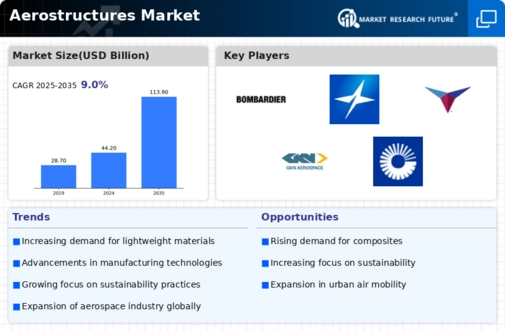-
Executive Summary
-
Market Attractiveness Analysis
- Global Aerostructures Market, by Component
- Global Aerostructures Market, by Material
- Global Aerostructures Market, by End Use
- Global Aerostructures Market, by Platform
- Global Aerostructures Market, by Region
-
Market Introduction
-
Market Definition
-
Scope of the Study
-
Market Structure
-
Key Buying Criteria
-
Market Factor Indicator Analysis
-
Research Methodology
-
Research Process
-
Primary Research
-
Secondary Research
-
Market Size Estimation
-
Forecast Model
-
List of Assumptions
-
Market Insights
-
Market Dynamics
-
Introduction
-
Drivers
-
Restraints
-
Opportunities
-
Challenges
-
Market/Technological Trends
-
Patent Trends
-
Regulatory Landscape/Standards
-
Market Factor Analysis
-
Value Chain/Supply Chain Analysis
- R&D
- Manufacturing
- Distribution & Sales
- Post-Sales Monitoring
-
Porter’s Five Forces Analysis
- Threat of New Entrants
- Bargaining Power of Buyers
- Threat of Substitutes
- Competitive Rivalry
- Bargaining Power of Supplies
-
Global Aerostructures Market, by Component
-
Introduction
-
Fuselage
- Market Estimates & Forecast, 2020–2030
- Market Estimates & Forecast, by Region, 2020–2030
-
Empennage
- Market Estimates & Forecast, 2020–2030
- Market Estimates & Forecast, by Region, 2020–2030
-
Flight Control Surfaces
- Market Estimates & Forecast, 2020–2030
- Market Estimates & Forecast, by Region, 2020–2030
-
Wings
- Market Estimates & Forecast, 2020–2030
- Market Estimates & Forecast, by Region, 2020–2030
-
Nose
- Market Estimates & Forecast, 2020–2030
- Market Estimates & Forecast, by Region, 2020–2030
-
Nacelle & Pylon
- Market Estimates & Forecast, 2020–2030
- Market Estimates & Forecast, by Region, 2020–2030
-
Others
- Market Estimates & Forecast, 2020–2030
- Market Estimates & Forecast, by Region, 2020–2030
-
Global Aerostructures Market, by Material
-
Introduction
-
Composite
- Market Estimates & Forecast, 2020–2030
- Market Estimates & Forecast, by Region, 2020–2030
-
Alloys
- Market Estimates & Forecast, 2020–2030
- Market Estimates & Forecast, by Region, 2020–2030
-
Metals
- Market Estimates & Forecast, 2020–2030
- Market Estimates & Forecast, by Region, 2020–2030
-
Global Aerostructures Market, by End Use
-
Introduction
-
Original Equipment Manufacturers (OEMs)
- Market Estimates & Forecast, 2020–2030
- Market Estimates & Forecast, by Region, 2020–2030
-
Aftermarket
- Market Estimates & Forecast, 2020–2030
- Market Estimates & Forecast, by Region, 2020–2030
-
Global Aerostructures Market, by Platform
-
Introduction
-
Fixed-Wing
- Market Estimates & Forecast, 2020–2030
- Market Estimates & Forecast, by Region, 2020–2030
-
Rotary-Wing
- Market Estimates & Forecast, 2020–2030
- Market Estimates & Forecast, by Region, 2020–2030
-
Global Aerostructures Market, by Region
-
Introduction
-
North America
- Market Estimates & Forecast, by Country, 2020–2030
- Market Estimates & Forecast, by Component, 2020–2030
- Market Estimates & Forecast, by Material, 2020–2030
- Market Estimates & Forecast, by End Use, 2020–2030
- Market Estimates & Forecast, by Platform, 2020–2030
- US
- Canada
-
Europe
- Market Estimates & Forecast, by Country, 2020–2030
- Market Estimates & Forecast, by Component, 2020–2030
- Market Estimates & Forecast, by Material, 2020–2030
- Market Estimates & Forecast, by End Use, 2020–2030
- Market Estimates & Forecast, by Platform, 2020–2030
- UK
- Germany
- France
- Russia
- Rest of Europe
-
Asia-Pacific
- Market Estimates & Forecast, by Country, 2020–2030
- Market Estimates & Forecast, by Component, 2020–2030
- Market Estimates & Forecast, by Material, 2020–2030
- Market Estimates & Forecast, by End Use, 2020–2030
- Market Estimates & Forecast, by Platform, 2020–2030
- China
- Japan
- India
- Rest of Asia-Pacific
-
Middle East & Africa
- Market Estimates & Forecast, by Country, 2020–2030
- Market Estimates & Forecast, by Component, 2020–2030
- Market Estimates & Forecast, by Material, 2020–2030
- Market Estimates & Forecast, by End Use, 2020–2030
- Market Estimates & Forecast, by Platform, 2020–2030
- UAE
- Saudi Arabia
- Rest of the Middle East & Africa
-
Latin America
- Market Estimates & Forecast, by Country, 2020–2030
- Market Estimates & Forecast, by Component, 2020–2030
- Market Estimates & Forecast, by Material, 2020–2030
- Market Estimates & Forecast, by End Use, 2020–2030
- Market Estimates & Forecast, by Platform, 2020–2030
- Brazil
- Rest of Latin America
-
Competitive Landscape
-
Competitive Overview
-
Competitor Dashboard
-
Major Growth Strategies in the Global Aerostructures Market
-
Competitive Benchmarking
-
Market Share Analysis
-
Key Developments & Growth Strategies
- Product Launches/Service Deployments
- Mergers & Acquisitions
- Joint Ventures
-
Company Profiles
-
Aar Corp.
- Company Overview
- Products/Services Offered
- Financial Overview
- Key Developments
- SWOT Analysis
- Key Strategies
-
Bombardier Inc.
- Company Overview
- Products/Services Offered
- Financial Overview
- Key Developments
- SWOT Analysis
- Key Strategies
-
Cyient Ltd
- Company Overview
- Products/Services Offered
- Financial Overview
- Key Developments
- SWOT Analysis
- Key Strategies
-
Elbit Systems Ltd
- Company Overview
- Products/Services Offered
- Financial Overview
- Key Developments
- SWOT Analysis
- Key Strategies
-
GKN Aerospace
- Company Overview
- Products/Services Offered
- Financial Overview
- Key Developments
- SWOT Analysis
- Key Strategies
-
Other prominent companies profiled in the report:
-
Leonardo SpA
-
Ruag Group
-
Saab AB
-
Spirit Aerosystems, Inc.
-
Stelia Aerospace Group
-
Triumph Group, Inc.
-
UTC Aerospace Systems
-
Appendix
-
References
-
Related Reports
-
List of Abbreviations
-
Industry Insights
-
Note: This table of contents is tentative and subject to change as the research progresses.
-
-
List of Tables
-
Global Aerostructures Market, by Region, 2020–2030
-
North America: Aerostructures Market, by Country, 2020–2030
-
Europe: Aerostructures Market, by Country, 2020–2030
-
Asia-Pacific: Aerostructures Market, by Country, 2020–2030
-
Middle East & Africa: Aerostructures Market, by Country, 2020–2030
-
Latin America: Aerostructures Market, by Country, 2020–2030
-
Global Aerostructures Market, by Platform, 2020–2030
-
Global Aerostructures Market, by Type, 2020–2030
-
North America: Aerostructures Market, by Country, 2020–2030
-
North America: Aerostructures Market, by Component, 2020–2030
-
North America: Aerostructures Market, by Material, 2020–2030
-
North America: Aerostructures Market, by End Use, 2020–2030
-
North America: Aerostructures Market, by Platform, 2020–2030
-
US: Aerostructures Market, by Component, 2020–2030
-
US: Aerostructures Market, by Material, 2020–2030
-
US: Aerostructures Market, by End Use, 2020–2030
-
US: Aerostructures Market, by Platform, 2020–2030
-
Canada: Aerostructures Market, by Component, 2020–2030
-
Canada: Aerostructures Market, by Material, 2020–2030
-
Canada: Aerostructures Market, by End Use, 2020–2030
-
Canada: Aerostructures Market, by Platform, 2020–2030
-
Europe: Aerostructures Market, by Country, 2020–2030
-
Europe: Aerostructures Market, by Component, 2020–2030
-
Europe: Aerostructures Market, by Material, 2020–2030
-
Europe: Aerostructures Market, by End Use, 2020–2030
-
Europe: Aerostructures Market, by Platform, 2020–2030
-
Germany: Aerostructures Market, by Component, 2020–2030
-
Germany: Aerostructures Market, by Material, 2020–2030
-
Germany: Aerostructures Market, by End Use, 2020–2030
-
Germany: Aerostructures Market, by Platform, 2020–2030
-
UK: Aerostructures Market, by Component, 2020–2030
-
UK: Aerostructures Market, by Material, 2020–2030
-
UK: Aerostructures Market, by End Use, 2020–2030
-
UK: Aerostructures Market, by Platform, 2020–2030
-
France: Aerostructures Market, by Component, 2020–2030
-
France: Aerostructures Market, by Material, 2020–2030
-
France: Aerostructures Market, by End Use, 2020–2030
-
France: Aerostructures Market, by Platform, 2020–2030
-
Russia: Aerostructures Market, by Component, 2020–2030
-
Russia: Aerostructures Market, by Material, 2020–2030
-
Russia: Aerostructures Market, by End Use, 2020–2030
-
Russia: Aerostructures Market, by Platform, 2020–2030
-
Rest of Europe: Aerostructures Market, by Component, 2020–2030
-
Rest of Europe: Aerostructures Market, by Material, 2020–2030
-
Rest of Europe: Aerostructures Market, by End Use, 2020–2030
-
Rest of Europe: Aerostructures Market, by Platform, 2020–2030
-
Asia-Pacific: Aerostructures Market, by Country, 2020–2030
-
Asia-Pacific: Aerostructures Market, by Component, 2020–2030
-
Asia-Pacific: Aerostructures Market, by Material, 2020–2030
-
Asia-Pacific: Aerostructures Market, by End Use, 2020–2030
-
Asia-Pacific: Aerostructures Market, by Platform, 2020–2030
-
China: Aerostructures Market, by Component, 2020–2030
-
China: Aerostructures Market, by Material, 2020–2030
-
China: Aerostructures Market, by End Use, 2020–2030
-
China: Aerostructures Market, by Platform, 2020–2030
-
Japan: Aerostructures Market, by Component, 2020–2030
-
Japan: Aerostructures Market, by Material, 2020–2030
-
Japan: Aerostructures Market, by End Use, 2020–2030
-
Japan: Aerostructures Market, by Platform, 2020–2030
-
India: Aerostructures Market, by Component, 2020–2030
-
India: Aerostructures Market, by Material, 2020–2030
-
India: Aerostructures Market, by End Use, 2020–2030
-
India: Aerostructures Market, by Platform, 2020–2030
-
Rest of Asia-Pacific: Aerostructures Market, by Component, 2020–2030
-
Rest of Asia-Pacific: Aerostructures Market, by Material, 2020–2030
-
Rest of Asia-Pacific: Aerostructures Market, by End Use, 2020–2030
-
Rest of Asia-Pacific: Aerostructures Market, by Platform, 2020–2030
-
Middle East & Africa: Aerostructures Market, by Country, 2020–2030
-
Middle East & Africa: Aerostructures Market, by Component, 2020–2030
-
Middle East & Africa: Aerostructures Market, by Material, 2020–2030
-
Middle East & Africa: Aerostructures Market, by End Use, 2020–2030
-
Middle East & Africa: Aerostructures Market, by Platform, 2020–2030
-
UAE: Aerostructures Market, by Component, 2020–2030
-
UAE: Aerostructures Market, by Material, 2020–2030
-
UAE: Aerostructures Market, by End Use, 2020–2030
-
UAE: Aerostructures Market, by Platform, 2020–2030
-
Saudi Arabia: Aerostructures Market, by Component, 2020–2030
-
Saudi Arabia: Aerostructures Market, by Material, 2020–2030
-
Saudi Arabia: Aerostructures Market, by End Use, 2020–2030
-
Saudi Arabia: Aerostructures Market, by Platform, 2020–2030
-
Rest of the Middle East & Africa: Aerostructures Market, by Component, 2020–2030
-
Rest of the Middle East & Africa: Aerostructures Market, by Material, 2020–2030
-
Rest of the Middle East & Africa: Aerostructures Market, by End Use, 2020–2030
-
Rest of the Middle East & Africa: Aerostructures Market, by Platform, 2020–2030
-
Latin America: Aerostructures Market, by Country, 2020–2030
-
Latin America: Aerostructures Market, by Component, 2020–2030
-
Latin America: Aerostructures Market, by Material, 2020–2030
-
Latin America: Aerostructures Market, by End Use, 2020–2030
-
Latin America: Aerostructures Market, by Platform, 2020–2030
-
Brazil: Aerostructures Market, by Component, 2020–2030
-
Brazil: Aerostructures Market, by Material, 2020–2030
-
Brazil: Aerostructures Market, by End Use, 2020–2030
-
Brazil: Aerostructures Market, by Platform, 2020–2030
-
Rest of Latin America: Aerostructures Market, by Component, 2020–2030
-
Rest of Latin America: Aerostructures Market, by Material, 2020–2030
-
Rest of Latin America: Aerostructures Market, by End Use, 2020–2030
-
Rest of Latin America: Aerostructures Market, by Platform, 2020–2030
-
-
List of Figures
-
Research Process of MRFR
-
Top-Down & Bottom-Up Approaches
-
Market Dynamics
-
Impact Analysis: Market Drivers
-
Impact Analysis: Market Restraints
-
Porter''s Five Forces Analysis
-
Value Chain Analysis
-
Global Aerostructures Market Share, by Component, 2020 (%)
-
Global Aerostructures Market, by Component, 2020–2030 (USD Million)
-
Global Aerostructures Market Share, by Material, 2020 (%)
-
Global Aerostructures Market, by Material, 2020–2030 (USD Million)
-
Global Aerostructures Market Share, by End Use, 2020 (%)
-
Global Aerostructures Market, by End Use, 2020–2030 (USD Million)
-
Global Aerostructures Market Share, by Platform, 2020 (%)
-
Global Aerostructures Market, by Platform, 2020–2030 (USD Million)
-
Global Aerostructures Market Share (%), by Region, 2020
-
Global Aerostructures Market, by Region, 2020–2030 (USD Million)
-
North America: Aerostructures Market Share (%), 2020
-
North America: Aerostructures Market, by Country, 2020–2030 (USD Million)
-
Europe: Aerostructures Market Share (%), 2020
-
Europe: Aerostructures Market, by Country, 2020–2030 (USD Million)
-
Asia-Pacific: Aerostructures Market Share (%), 2020
-
Asia-Pacific: Aerostructures Market, by Country, 2020–2030 (USD Million)
-
Middle East & Africa: Aerostructures Market Share (%), 2020
-
Middle East & Africa: Aerostructures Market, by Country, 2020–2030 (USD Million)
-
Latin America: Aerostructures Market Share (%), 2020
-
Latin America: Aerostructures Market, by Country, 2020–2030 (USD Million)

















Leave a Comment